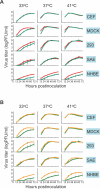Growth of H5N1 influenza A viruses in the upper respiratory tracts of mice
- PMID: 17922570
- PMCID: PMC2000968
- DOI: 10.1371/journal.ppat.0030133
Growth of H5N1 influenza A viruses in the upper respiratory tracts of mice
Abstract
Highly pathogenic avian H5N1 influenza A viruses have spread throughout Asia, Europe, and Africa, raising serious worldwide concern about their pandemic potential. Although more than 250 people have been infected with these viruses, with a consequent high rate of mortality, the molecular mechanisms responsible for the efficient transmission of H5N1 viruses among humans remain elusive. We used a mouse model to examine the role of the amino acid at position 627 of the PB2 viral protein in efficient replication of H5N1 viruses in the mammalian respiratory tract. Viruses possessing Lys at position 627 of PB2 replicated efficiently in lungs and nasal turbinates, as well as in cells, even at the lower temperature of 33 degrees C. Those viruses possessing Glu at this position replicated less well in nasal turbinates than in lungs, and less well in cells at the lower temperature. These results suggest that Lys at PB2-627 confers to avian H5N1 viruses the advantage of efficient growth in the upper and lower respiratory tracts of mammals. Therefore, efficient viral growth in the upper respiratory tract may provide a platform for the adaptation of avian H5N1 influenza viruses to humans and for efficient person-to-person virus transmission, in the context of changes in other viral properties including specificity for human (sialic acid alpha-2,6-galactose containing) receptors.
Conflict of interest statement
Figures

References
-
- Subbarao K, Klimov A, Katz J, Regnery H, Lim W, et al. Characterization of an avian influenza A (H5N1) virus isolated from a child with a fatal respiratory illness. Science. 1998;279:393–396. - PubMed
-
- Claas EC, Osterhaus AD, van BR, De Jong JC, Rimmelzwaan GF, et al. Human influenza A H5N1 virus related to a highly pathogenic avian influenza virus. Lancet. 1998;351:472–477. - PubMed
-
- World Health Organization. Cumulative Number of Confirmed Human Cases of Avian Influenza A/(H5N1) Reported to WHO, 2 April 2007. Geneva: World Health Organization; 2007.
Publication types
MeSH terms
Substances
LinkOut - more resources
Full Text Sources
Other Literature Sources
Medical

